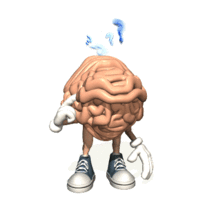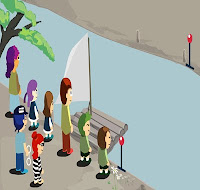Can you believe it, we're heading into week 4 already! That dynamo has well and truly ground itself back into action and we are almost up to full speed on the treadmill. Do you think that teachers do a good impression of a one man band with our repertoire of innovative ideas and a range of tools to implement them?
So...my plans for the year ahead...in no particular order, more moodling, making full use of students mobile phones in class, thus turning a blind eye to the "thou shalt not use one's mobile phone is class" rule (ah well, rules are made to be broken anyway!), social networking with schools from overseas via Skype, loads of podcast, cartoon strip, video creating (by my students, not me!) and then uploading their creative resources to Mahara to be accessed by other students in our class. It's going to be a busy year for my lot.
Today I'll start with...
The school that I am working in (along with another 30,000 or so others around the globe) uses moodle as its platform for the school intranet. I'm planning on continuing to upload my teaching resources such as powerpoints, word docs, animations, video clips etc for my students to view and download if they so wish (nothing strange or unusual there, most schools seem to use their intranet in that manner) but I would like to use moodle in a more collaborative manner and interactive manner.
One means in which to do that is with the forums so that students can discuss scientific issues relevant to our lessons such as "according to MRS C GREN is fire a living thing?". (MRS C GREN is a mnemonic for the charachteristics of living things). I'll also get them thinking on their prior knowledge at the beginning of a topic with forums titled "what do I know about light", "what would I like to know about plants?" etc.. They can discuss and debate issues online such as "Is nuclear power the fuel for the future", "What are the effects of global warming" etc...
There are 4 different types of forum...
1) single simple discussion, in which the entire forum is on one page, the first post, usually initiated by the teacher sits at the top of page. This option is good for short highly focused discussions.
2) standard forum anyone can start a new topic.
3) each person posts one discussion, everyone can create one discussion and reply to all.
4) Q and A forum. teacher creates the forum and students reply, however a student cannot see anyone's else's post until they have posted a reply,
Students usually enjoy attempting the Hot Potatoes quizzes as a part of their learning and on completion challenge themselves with multiple attempts in order to improve their overall score. One of the many fabulous things about the moodle program is that it will grade the quizzes (saving you time!) and also provide an indication of how long it took the student to complete it and how many attempts were taken, thus providing very useful statistics for you.
Hot Potatoes is free to download from here http://hotpot.uvic.ca/#downloadsIt is a program that enables educators (and students) to create interactive quizzes. The five different types are multiple-choice, matching, cloze (gap-fill), crossword and short-answer. It is also possible to add images, videos and animations which many teachers find useful. Click
here for info on how to make and upload a Hot Potatoes quiz.
Glossaries are another useful too, students can be given editing rights to define a subject specific word within a glossary or add a new word to which other students can define. This can be useful as an exercise to create a glossary from newspaper articles, subject specific terminology or websites about current affairs in Science etc... As a bit of an add-on I have put a random access glossary in the side-bar so that every so often a word and its definition flash up in the sidebar. I quite like random photos to show up in the sidebar and have simply added photos with their description to a glossary and then selected random access in the sidebar.
In this ego-centric world of myspace, twitter, facebook and hey, particularly blogging! :-) students love to see photos of themselves, which can be uploaded to moodle using the slideshow option. This could easily be used to take photos of students doing experiment work such as dissections, titrations, indicators tests etc... the list goes on! See below an image from my extra-curricular surfing moodle page where I have inserted an image in a label, as well as set up a glossary of photos with the random access glossary in the sidebar and the actual slideshow of photos is further down the moodle page (not visible on this screen capture)

According to Using moodle 2nd edition, Jason Cole and Helen Foster 2008 http://issuu.com/iusher/docs/usingmoodle2 "More than 30,000 educational institutions around the world currently use moodle to deliver online courses and to supplement traditional face to face courses."
Moodle is open source software for collaborative learning, it is free to download and use, see here http://.moodle.org for more information and a community of educators who are more than willing to help and offer suggestions on its use in the classroom. Once you're logged onto the moodle site have a read of this article "The good teacher", a wee anecdote as to how an innovative "pretty good teacher" became a "very good teacher" with the aid of another teacher and the moodle program. Moodle is a superb program, I am hooked, a "Born Again Moodler" if you will, however a word of warning, a good tool such as moodle as only as good as the teacher that uses it, in order to ensure and rich and positive learning experience I would suggest that you take the time to read William H. Rice's excellent book titled
"Moodle teaching techniques", which does exactly what it says on the cover. It is a valuable resource, which many ideas and focuses on best practices for constructing learning solutions.
He states the moodle philosophy is based on the constructivist approach, which follows 4 main principles, which are that
1) students acquire new knowledge as they interact with their environment, your course activities and other students
2) Students learn more when they construct learning experiences for others. You might be familiar with the “learning pyramid”, see below
3) when students become part of a culture, they are constantly learning
4) some students try to remain objective and factual, some try to accept more subjective views, and other try to integrate both approaches. Constructed behaviour is when a student can choose whichever approach is more appropriate"
If you are interested on reading more about learning styles, please see my previous blog dated 14th Feb 2010, if not... then I urge you to check out Michael Fisher's
DigiGogy blog and
wiki with his visual representation of the new version of Bloom's taxonomy.
The following is an outline of how I used moodle with one of my Year 9 (aged 14years) Science classes last year, it was for a unit on Forensic Science that was written by one of my colleagues. I adapted the unit to include a range of ICT tools for students to create resources. Firstly, they had to crack the code (enrolment key) to get onto the moodle page. The undeciphered code had been dropped by a witness to the crime on paper with invisible ink (glow in the dark nail polish) which showed up using a UV light. I made an intro video using
Microsoft Movie Maker and converted it to a shockwave file using the free
Quick Media Converter program. I uploaded the shockwave video file to moodle, making sure that it was in not in a secondary folder, then add a resources --> insert a label, clicked this symbol on the top right called toggle HTML source

and inserted the following
HTML code (please note, you need to know absolutely nothing about HTML code to do this, don't be afraid :-) give it a go, you cannot break moodle!
The end result was a intro video that played automatically as soon as the students logged onto the Crime Scene Investigation webpage on moodle.
The students were put into mixed ability groups and decided on roles as forensic scientists, advanced forensic scientists, journalists and discussed ideas with students from other groups using the jigsaw model, wherein they would divide into specialist groups, research and discuss ideas together and come back into their initial groups. This ensure that collaborative learning is taking place within differentiated groups. The students used GPS's to make their way to the makeshift crime scene and viewed the crime scene while wearing hair nets, shoe covers, lab coats, gloves and taken some photographs of the crimescene the used files save on moodle to help them with research on what forensic tests to carry out.
On the current version of the moodle program it isn't possible for students to click on images to view word docs etc within the files, in my case they were given access the files. I have been told that an updated version of moodle will allow this.
Next, the more able students, known as the Advanced Forensic scientists read the following info and clicked on the hyperlinks to access more info on the experiments to carry out. I inserted a gif animation on the right hand side of the page which was a model of rotating DNA model.
Finally, the journalists were instructed to update the public with their findings as they tried to solve the crime, they had to produce
Word docs and videos were uploaded to moodle to help the students with producing their podcasts, newspaper articles and videos.
All in all, the Forensic Science unit lasted 12 lessons, it was very successful. The students worked brilliantly together as they set their own pace and decided on the tasks that needed to be carried out then concluded who it was that carried out the crime. The enjoyed the tasks at hand, students learn best when feeling positive about themselves and their learning environment and they produced superb creative resources.
"Happy New Year. This year I’ll eat more green vegetables and less red meat and less chocolate, chocolate cake, chocolate pudding, and chocolate cheesecake. I’ll drink less beer and less red wine and more chilled cucumber juice.
I’ll do more vigorous exercise, like walking briskly to work. I’ll take up a sport – golf perhaps, swimming, or maybe surfing. I’ll smile more. I’ll be kind, maybe even sympathetic, to ERO people.
This year I’ll go to bed earlier and I’ll read more fiction. (The Book of Unholy Mischief by Elle Newmark – as gripping as it was delicious.) I’ll be more tolerant of others’ differences and I’ll be more patient. I’ll accept silliness and laugh it to one side. I’ll not watch the TV news.
I’ll construct detailed schemes of work, or curriculum maps or unit plans and reflect on lessons and make notes for improvements. I’ll work with colleagues to develop cross-curricular units and I’ll stay late after school to help with an on-stage extravaganza. I’ll develop dynamic and stimulating lesson materials that combine PowerPoint with Web2.0 and twitter....cont"








































